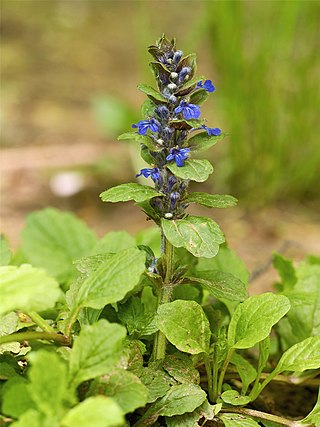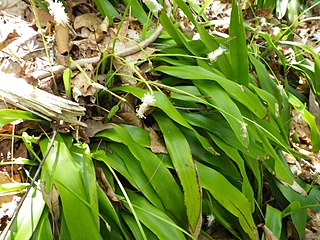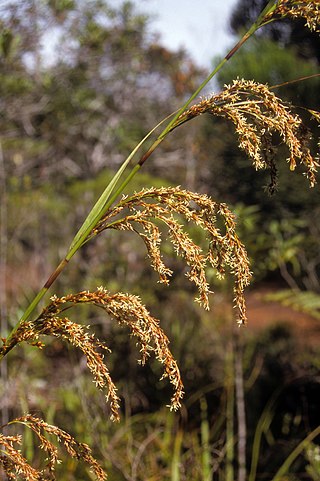
The Cyperaceae are a family of graminoid (grass-like), monocotyledonous flowering plants known as sedges. The family is large, with some 5,500 known species described in about 90 genera, the largest being the "true sedges" genus Carex with over 2,000 species.

Ajuga, also known as bugleweed, ground pine, carpet bugle, or just bugle, is a genus of flowering plants in the Ajugeae tribe of the mint family Lamiaceae. There are over 60 species of annual or perennial, mostly herbaceous plants. They are native to Europe, Asia, Africa, and Australia.

Typhonium is a genus in the family Araceae native to eastern and southern Asia, New Guinea, and Australia. It is most often found growing in wooded areas.
- Typhonium acetosellaGagnep. - Cambodia, Laos, Thailand, Vietnam
- Typhonium adnatumHett. & Sookch. - Thailand
- Typhonium albidinerviumC.Z.Tang & H.Li - Guangdong, Hainan, Laos, Thailand
- Typhonium albispathumBogner - Thailand
- Typhonium alismifoliumF.Muell. - Queensland, Northern Territory
- Typhonium angustilobumF.Muell. - Queensland, New Guinea
- Typhonium bachmaenseV.D.Nguyen & Hett. - Vietnam
- Typhonium baoshanenseZ.L.Dao & H.Li - Yunnan
- Typhonium blumeiNicolson & Sivad. - Japan, Taiwan, Ryukyu Islands, much of China, Bangladesh, Laos, Cambodia, Myanmar, Thailand, Vietnam; naturalized in Madagascar, Mauritius, Comoros, Borneo, Philippines, West Indies
- Typhonium bognerianumJ.Murata & Sookch. - Thailand
- Typhonium browniiSchott - Queensland, New South Wales
- Typhonium bulbiferumDalzell - southern India
- Typhonium circinnatumHett. & J.Mood - Vietnam
- Typhonium cochleareA.Hay - Northern Territory of Australia
- Typhonium cordifoliumS.Y.Hu - Thailand
- Typhonium digitatumHett. & Sookch. - Thailand
- Typhonium echinulatumHett. & Sookch. - Thailand
- Typhonium eliosurum(F.Muell. ex Benth.) O.D.Evans - New South Wales
- Typhonium filiformeRidl. - Thailand, Malaysia
- Typhonium flagelliforme(G.Lodd.) Blume - Guangdong, Guangxi, Yunnan, Bangladesh, Bhutan, Cambodia, India, Indonesia, Laos, Malaysia, Myanmar, Philippines, Singapore, Sri Lanka, Thailand, New Guinea, Queensland, Northern Territory
- Typhonium fultumRidl. - Thailand, Malaysia
- Typhonium gagnepainiiJ.Murata & Sookch. - Thailand, Cambodia
- Typhonium gallowayiHett. & Sookch. - Thailand
- Typhonium glaucumHett. & Sookch. - Thailand
- Typhonium griseumHett. & Sookch. - Thailand
- Typhonium hayataeSriboonma & J.Murata - Vietnam
- Typhonium huenseNguyen & Croat - Vietnam
- Typhonium hunanenseH.Li & Z.Q.Liu - Hunan
- Typhonium inopinatumPrain - India, Myanmar, Thailand
- Typhonium jinpingenseZ.L.Wang, H.Li & F.H.Bian - Yunnan
- Typhonium johnsonianumA.Hay & S.M.Taylor - Northern Territory of Australia
- Typhonium jonesiiA.Hay - Northern Territory of Australia
- Typhonium laoticumGagnep. - Thailand, Laos
- Typhonium liliifoliumF.Muell. ex Schott - Northern Territory, Western Australia
- Typhonium lineareHett. & V.D.Nguyen - Vietnam
- Typhonium listeriPrain - Assam, Bangladesh, Myanmar
- Typhonium medusaeHett. & Sookch. - Thailand
- Typhonium mirabile(A.Hay) A.Hay - Melville Island of Australia
- Typhonium neogracileJ.Murata - Assam, Bangladesh, Myanmar
- Typhonium nudibaccatumA.Hay - Western Australia
- Typhonium orbifoliumHett. & Sookch. - Thailand
- Typhonium pedatisectumGage - Myanmar
- Typhonium pedunculatumHett. & Sookch. - Thailand
- Typhonium peltandroidesA.Hay, M.D.Barrett & R.L.Barrett - Western Australia
- Typhonium penicillatumV.D.Nguyen & Hett. - Vietnam
- Typhonium pottingeriPrain - Myanmar
- Typhonium praecoxJ.Murata - Myanmar
- Typhonium praetermissumA.Hay - Northern Territory of Australia
- Typhonium pusillumSookch., V.D.Nguyen & Hett. - Thailand
- Typhonium reflexumHett. & Sookch. - Thailand
- Typhonium roxburghiiSchott - Taiwan, Yunnan, Bonin Islands, India, Bangladesh, Sri Lanka, Andaman Islands, Thailand, Malaysia, western Indonesia, Philippines, New Guinea; naturalized in Western Australia, eastern Brazil, Tanzania
- Typhonium russell-smithiiA.Hay - Northern Territory of Australia
- Typhonium sagittariifoliumGagnep. - Thailand
- Typhonium saraburiensisSookch., Hett. & J.Murata - Thailand
- Typhonium sinhabaedyaeHett. & A.Galloway - Thailand
- Typhonium smitinandiiSookch. & J.Murata - Thailand
- Typhonium stigmatilobatumV.D.Nguyen - Vietnam
- Typhonium subglobosumHett. & Sookch. - Thailand
- Typhonium tayloriiA.Hay - Northern Territory of Australia
- Typhonium trifoliatumF.T.Wang & H.S.Lo ex H.Li, Y.Shiao & S.L.Tseng - Mongolia, Hebei, Inner Mongolia, Shaanxi, Shanxi
- Typhonium trilobatum(L.) Schott - southern China, Indian Subcontinent, Indochina; naturalized in Windward Islands, Ivory Coast, Borneo, Philippines
- Typhonium tubispathumHett. & A.Galloway - Thailand
- Typhonium variansHett. & Sookch. - Thailand
- Typhonium vermiformeV.D.Nguyen & Croat - Vietnam
- Typhonium violifoliumGagnep. - Myanmar, Thailand
- Typhonium watanabeiJ.Murata, Sookch. & Hett. - Thailand
- Typhonium weipanumA.Hay - Queensland
- Typhonium wilbertiiA.Hay - Queensland

Rhynchospora is a genus of about 400 species of sedges with a cosmopolitan distribution. The genus includes both annual and perennial species, mostly with erect 3-sided stems and 3-ranked leaves. The achenes bear a beak-like tubercule and are sometimes subtended by bristles. Many of the species are similar in vegetative appearance, and mature fruits are needed to make a positive identification.

Hypolytrum is a genus of plant in the family Cyperaceae. It contains approximately 60–70 species, native to tropical Africa, Asia, Australia, Latin America and various oceanic islands.

Uncinia is a genus of flowering plants in the family Cyperaceae, known as hook-sedges in Australia and as hook grasses or bastard grasses in New Zealand. The genus is characterised by the presence of a long hook formed by an extension of the rachilla, which is used to attach the fruit to passing animals (epizoochory), especially birds, and it is this feature which gives the genus its name, from the Latin uncinus, meaning a hook or barb.

Halodule is a genus of plants in the family Cymodoceaceae described as a genus in 1841. It is widespread on tropical and semi-tropical ocean shores of all continents except Europe and Antarctica.

Lepidosperma is a genus of flowering plant of the family Cyperaceae. Most of the species are endemic to Australia, with others native to southern China, southeast Asia, New Guinea, New Caledonia and New Zealand.

Gahnia is a genus of sedges native to China, Southeast Asia, New Guinea, Australia, New Zealand and a number of Pacific Islands. The common name is due to the toothed margins. It often forms tussocks.

Kyllinga is genus of flowering plants in the sedge family known commonly as spikesedges. They are native to tropical and warm temperate areas of the world, especially tropical Africa. These sedges vary in morphology, growing to heights from 2.5 centimeters to a meter and sometimes lacking rhizomes. They are closely related to Cyperus species and sometimes treated as part of a more broadly circumscribed Cyperus.

Ficinia is a genus of tufted or rhizomatous sedges in the family Cyperaceae. There are around 70 recognised species in Africa, four species that occur in New Zealand and a single species Ficinia nodosa that occurs in Australia.

Mesomelaena is a genus of sedges. It has 5 known species, all endemic to Western Australia.

Schoenoplectus pungens is a species of flowering plant in the sedge family known as common threesquare, common three-square bulrush and sharp club-rush. It is a herbaceous emergent plant that is widespread across much of North and South America as well as Europe, New Zealand and Australia.

Lipocarpha is a genus of sedges known as halfchaff sedges. There are approximately 35 species and representatives can be found throughout the tropical and warmer temperate areas of Africa, Asia, Australia, North America, South America and various oceanic islands. These mostly are erect annual herbs growing 1 to 30 centimeters tall. The inflorescence consists of one to few spikes each containing many spirally arranged spikelets. The flower is entangled with two hyalin scales, a spikelet prophyll and a glume. These flower stands in the axil of a spikelet-bract.
Fimbristylis polytrichoides is a species of fimbry known by the common name rusty sedge, native to east Africa, Madagascar, China, Southeast Asia, New Guinea and Australia. The plant is common along the coast line and estuaries of Australia. The flowers are a distinctive rusty brown color appearing on a single spikelet from May to July.

Isolepis is a genus of flowering plants in the sedge family, containing around 70 species. Isolepis is cosmopolitan, and often found in cool tropical and temperate climates in Africa and Australasia.

Coleochloa is a plant genus in the family Cyperaceae. It is found in sub-Saharan Africa and on the Island of Madagascar.

Carex fraseriana is a perennial member of the sedge family with the common name Fraser's sedge. It was the only species of the genus Cymophyllus before it was re-transferred to Carex.
Cyperus pulchellus is a sedge of the family Cyperaceae that is native to northern Australia, tropical Africa, northwest Madagascar and Southeast Asia.

Costularia is a plant genus in the family Cyperaceae. It includes 15 species native to southeastern Africa, ranging from South Africa through Eswatini, Mozambique, Zimbabwe, and Malawi, and to the islands Madagascar, Réunion, and the Seychelles in the Western Indian Ocean.


















